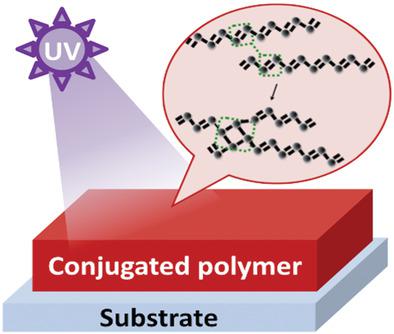当前位置:
X-MOL 学术
›
Adv. Energy Mater.
›
论文详情
Our official English website, www.x-mol.net, welcomes your
feedback! (Note: you will need to create a separate account there.)
What is Killing Organic Photovoltaics: Light‐Induced Crosslinking as a General Degradation Pathway of Organic Conjugated Molecules
Advanced Energy Materials ( IF 24.4 ) Pub Date : 2020-01-15 , DOI: 10.1002/aenm.201903163 Olga R. Yamilova 1, 2 , Ilya V. Martynov 2 , Allison S. Brandvold 3 , Irina V. Klimovich 1, 2 , Alex H. Balzer 4 , Alexander V. Akkuratov 2 , Ilya E. Kusnetsov 2 , Natalie Stingelin 3, 4 , Pavel A. Troshin 1, 2
Advanced Energy Materials ( IF 24.4 ) Pub Date : 2020-01-15 , DOI: 10.1002/aenm.201903163 Olga R. Yamilova 1, 2 , Ilya V. Martynov 2 , Allison S. Brandvold 3 , Irina V. Klimovich 1, 2 , Alex H. Balzer 4 , Alexander V. Akkuratov 2 , Ilya E. Kusnetsov 2 , Natalie Stingelin 3, 4 , Pavel A. Troshin 1, 2
Affiliation

|
In view of a rapid development and increase in efficiency of organic solar cells, reaching their long‐term operational stability represents now one of the main challenges to be addressed on the way toward commercialization of this photovoltaic technology. However, intrinsic degradation pathways occurring in organic solar cells under realistic operational conditions remain poorly understood. The light‐induced dimerization of the fullerene‐based acceptor materials discovered recently is considered to be one of the main causes for burn‐in degradation of organic solar cells. In this work, it is shown that not only the fullerene derivatives but also different types of conjugated polymers and small molecules undergo similar light‐induced crosslinking regardless of their chemical composition and structure. In the case of conjugated polymers, crosslinking of macromolecules leads to a rapid increase in their molecular weight and consequent loss of solubility, which can be revealed in a straightforward way by gel permeation chromatography analysis via a reduction/loss of signal and/or smaller retention times. Results of this work, thus, shift the paradigm of research in the field toward designing a new generation of organic absorbers with enhanced intrinsic photochemical stability in order to reach practically useful operation lifetimes required for successful commercialization of organic photovoltaics.
中文翻译:

什么是杀死有机光伏的:光诱导交联作为有机共轭分子的一般降解途径
鉴于有机太阳能电池的快速发展和效率的提高,达到其长期的运行稳定性是目前在将这种光伏技术商业化的过程中要解决的主要挑战之一。然而,在实际操作条件下有机太阳能电池中发生的内在降解途径仍然知之甚少。最近发现的基于富勒烯的受体材料的光诱导二聚化被认为是有机太阳能电池老化降解的主要原因之一。在这项工作中,表明不仅富勒烯衍生物而且不同类型的共轭聚合物和小分子都会经历相似的光诱导交联,无论其化学组成和结构如何。对于共轭聚合物,大分子的交联导致其分子量快速增加,并因此导致溶解度损失,这可以通过凝胶渗透色谱分析以减少/丢失信号和/或缩短保留时间的简单方式揭示出来。因此,这项工作的结果使该领域的研究范式转向设计具有增强的内在光化学稳定性的新一代有机吸收剂,从而达到有机光伏成功商业化所需的实用寿命。
更新日期:2020-02-18
中文翻译:

什么是杀死有机光伏的:光诱导交联作为有机共轭分子的一般降解途径
鉴于有机太阳能电池的快速发展和效率的提高,达到其长期的运行稳定性是目前在将这种光伏技术商业化的过程中要解决的主要挑战之一。然而,在实际操作条件下有机太阳能电池中发生的内在降解途径仍然知之甚少。最近发现的基于富勒烯的受体材料的光诱导二聚化被认为是有机太阳能电池老化降解的主要原因之一。在这项工作中,表明不仅富勒烯衍生物而且不同类型的共轭聚合物和小分子都会经历相似的光诱导交联,无论其化学组成和结构如何。对于共轭聚合物,大分子的交联导致其分子量快速增加,并因此导致溶解度损失,这可以通过凝胶渗透色谱分析以减少/丢失信号和/或缩短保留时间的简单方式揭示出来。因此,这项工作的结果使该领域的研究范式转向设计具有增强的内在光化学稳定性的新一代有机吸收剂,从而达到有机光伏成功商业化所需的实用寿命。











































 京公网安备 11010802027423号
京公网安备 11010802027423号